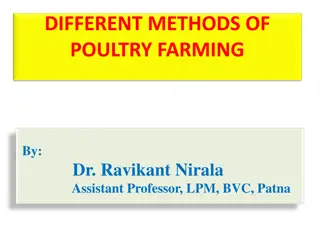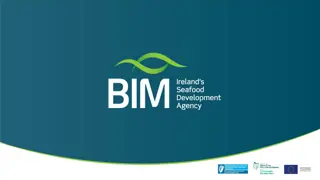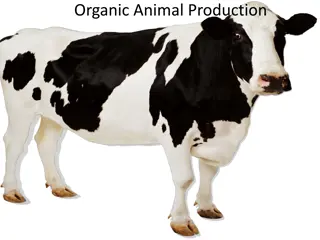Exploring Organic Communication Channels for Smart Farming Applications
Smart Farming research at The University of the West Indies focuses on Organic Communication Channels (OCCs) using vegetation-based media to transmit data for cyber-physical systems. The study aims to establish the feasibility and infrastructure for OCCs, including static channel characterization and proposing a standardized framework for communication. Potential applications include sensor data communication, channel sensing, RF strategy supplementation, and emergency communication in smart farming scenarios.
Download Presentation

Please find below an Image/Link to download the presentation.
The content on the website is provided AS IS for your information and personal use only. It may not be sold, licensed, or shared on other websites without obtaining consent from the author. Download presentation by click this link. If you encounter any issues during the download, it is possible that the publisher has removed the file from their server.
E N D
Presentation Transcript
Smart Farming: Organic Communication Channels (OCCs) Aaron Roopnarine and Sean Rocke Faculty of Engineering, The University of the West Indies, Trinidad IConETech-2020, Faculty of Engineering, The UWI, St. Augustine, Trinidad and Tobago
INTRODUCTION Organic Communication Channels (OCCs) are any hydrocarbon-based media which can be used to communicate data Extensive work has been done to characterize the human body and soil-based channels based on propagation techniques that utilize electric or magnetic fields. However, little work has been done to characterize vegetation-based channels [1-5] OCCs offer tremendous potential when incorporated into cyber-physical systems for smart farming- based applications through Organic Area Networks (OANs) The feasibility evaluation of OCCs is contingent upon channel characterization and proposal of a Physical Layer (PHY) infrastructure IConETech-2020, Faculty of Engineering, The UWI, St. Augustine, Trinidad and Tobago
OBJECTIVES Aim of Study To establish the relevance of, feasibility of and propose the infrastructure for OCCs Purpose of Research Set the foundation for the OCCs through: static channel characterization of vegetation-based OCCs + soil- based OCCs) proposing a standardized framework for OCC communication Establish the relevance of OCCs beyond current use cases through consideration of Internet of Farming (IoF) IConETech-2020, Faculty of Engineering, The UWI, St. Augustine, Trinidad and Tobago
Smart Farming: OCC Use Cases Vegetation-based OCCs can be used to: Communicate sensor data Obtain channel state through channel sensing Supplement current RF strategies Serve as emergency means of communication Animal-based Soil-based Oil-based Figure 1: Use cases for OCCs in smart farming scenarios
Related Work Figure 2: Related Work
METHODOLOGY: Channel Characterization Capacitive + Galvanic Coupling Magnetic Induction Coconut Tree Soil Papaya Tree (a) (b) Figure 3: (a) OCC electrode (b) Channel characterization set-up
RESULTS: Frequency Selectivity Vegetation and soil-based channels relatively flat Figure 4: Path loss versus frequency at different distances for OCCs
RESULTS: Path Loss Apparent fading with distance Figure 5: Path loss versus frequency at different distances for OCCs
RESULTS: BER Curves Figure 6: BER curves for the different OCCs investigated using the OCC PHY layer specification for transmission rates (a) 164 kbps (b)328 kbps (c) 656 kbps and (d)1.3125 Mbps
RESULTS: BER Curves Since an OCC system can theoretically achieve: A BER of 0 at data rates greater than 1kbps in some OCCs, then text data could be transmitted. BERs less than 1x10-2 for data rates above 80kbps, voice transmission at G.711 quality is feasible BERs less than 1x10-2, for data rates above 800kbps, low quality video can be transmitted IConETech-2020, Faculty of Engineering, The UWI, St. Augustine, Trinidad and Tobago
CONCLUSION OCCs offer great potential when integrated with cyber- physical systems as seen with the examination of use cases for smart farming applications. Vegetation-based (herbaceous and woody) and soil-based OCCs were characterised. The log-distance linear model was used to attempt to fit the magnitude response for the OCCs investigated. The magnitude of the path losses suggest OCCs may be well suited as an alternative to short-range RF communication if there is an organic channel between transceivers. The proposed OCC PHY layer showed feasible communication is possible using OCCs. In further work, dynamic channel models should be investigated for more channel types. Further, the MAC (Medium Access Control) layer for the IEEE 802.15.6 standard should be modified for all OCCs. IConETech-2020, Faculty of Engineering, The UWI, St. Augustine, Trinidad and Tobago
REFERENCES 1. M. A. Callejon, D. Naranjo-Hernandez, J. Reina-Tosina, and L. M. Roa, Distributed circuit modeling of galvanic and capacitive coupling for intrabody communication, IEEE Transactions on Biomedical Engineering, vol. 59, no. 11, pp. 3263 3269, 2012. M. H. Seyedi and D. Lai, A novel intrabody communication transceiver for biomedical applications, phd, Victoria University, 2014. N. Zedong, M. Jingjing, C. Hong, and W. Lei, Statistical characterization of the dynamic human body communication channel at 45mhz, in Engineering in Medicine and Biology Society (EMBC), 2013 35th Annual International Conference of the IEEE. IEEE, 2013, pp. 1206 1209. T. Ogasawara, A.-i. Sasaki, K. Fujii, and H. Morimura, Human body communication based on magnetic coupling, IEEE Transactions on Antennas and Propagation, vol. 62, no. 2, pp. 804 813, 2014. S. Kisseleff, I. F. Akyildiz, and W. H. Gerstacker, Survey on advances in magnetic induction-based wireless underground sensor networks, IEEE Internet of Things Journal, vol. 5, no. 6, pp. 4843 4856, Dec 2018 M. D. Pereira, G. A. Alvarez-Botero, and F. R. de Sousa, Characterization and modeling of the capacitive hbc channel, IEEE Transactions on Instrumentation and Measurement, vol. 64, no. 10, pp. 2626 2635, 2015 2. 3. 4. 5. 6. IConETech-2020, Faculty of Engineering, The UWI, St. Augustine, Trinidad and Tobago
THANK YOU! IConETech-2020, Faculty of Engineering, The UWI, St. Augustine, Trinidad and Tobago























